Global Inversion of Lunar Surface Oxides by Adding Chang’e-5 Samples
Abstract
1. Introduction
2. Data
2.1. Christiansen Feature
2.2. Diviner CF Map
2.3. Lunar Sampling Sites
3. Methods
3.1. Oxide Inversion Model
3.2. Model Parameters and Evaluation Index
4. Results
4.1. Correlation Coefficients between Oxides and CF Values
4.2. Model Accuracy Evaluation
4.3. Global Maps of Oxides
4.4. Three Geological Units and Interesting Regions of Chemical Abundances
5. Discussion
5.1. Comparison with Previous Studies
5.2. Implications of the Mg# Map
5.3. Limitations and Prospects
6. Conclusions
Author Contributions
Funding
Data Availability Statement
Conflicts of Interest
References
- Lucey, P.G.; Taylor, G.J.; Malaret, E. Abundance and Distribution of Iron on the Moon. Science 1995, 268, 1150–1153. [Google Scholar] [CrossRef] [PubMed]
- Otake, H.; Ohtake, M.; Hirata, N. Lunar Iron and Titanium Abundance Algorithms Based on SELENE (KAGUYA) Multiband Imager Data. In Proceedings of the 43rd Annual Lunar and Planetary Science Conference, Woodlands, TX, USA, 19–23 March 2012. [Google Scholar]
- Wu, Y. Major Elements and Mg# of the Moon: Results from Chang’E-1 Interference Imaging Spectrometer (IIM) Data. Geochim. Cosmochim. Acta 2012, 93, 214–234. [Google Scholar] [CrossRef]
- Lawrence, D.J.; Feldman, W.C.; Barraclough, B.L.; Binder, A.B.; Elphic, R.C.; Maurice, S.; Miller, M.C.; Prettyman, T.H. Thorium Abundances on the Lunar Surface. J. Geophys. Res. Planets 2000, 105, 20307–20331. [Google Scholar] [CrossRef]
- Lawrence, D.J.; Feldman, W.C.; Barraclough, B.L.; Binder, A.B.; Elphic, R.C.; Maurice, S.; Miller, M.C.; Prettyman, T.H. High Resolution Measurements of Absolute Thorium Abundances on the Lunar Surface. Geophys. Res. Lett. 1999, 26, 2681–2684. [Google Scholar] [CrossRef]
- Lawrence, D.J.; Feldman, W.C.; Barraclough, B.L.; Binder, A.B.; Elphic, R.C.; Maurice, S.; Thomsen, D.R. Global Elemental Maps of the Moon: The Lunar Prospector Gamma-Ray Spectrometer. Science 1998, 281, 1484–1489. [Google Scholar] [CrossRef] [PubMed]
- Prettyman, T.H.; Hagerty, J.J.; Elphic, R.C.; Feldman, W.C.; Lawrence, D.J.; McKinney, G.W.; Vaniman, D.T. Elemental Composition of the Lunar Surface: Analysis of Gamma Ray Spectroscopy Data from Lunar Prospector. J. Geophys. Res. Planets 2006, 111, E12007. [Google Scholar] [CrossRef]
- Elphic, R.C.; Lawrence, D.J.; Feldman, W.C.; Barraclough, B.L.; Gasnault, O.M.; Maurice, S.; Lucey, P.G.; Blewett, D.T.; Binder, A.B. Lunar Prospector Neutron Spectrometer Constraints on TiO2. J. Geophys. Res. Planets 2002, 107, 8-1–8-9. [Google Scholar] [CrossRef]
- Elphic, R.C.; Lawrence, D.J.; Feldman, W.C.; Barraclough, B.L.; Maurice, S.; Binder, A.B.; Lucey, P.G. Lunar Rare Earth Element Distribution and Ramifications for FeO and TiO2: Lunar Prospector Neutron Spectrometer Observations. J. Geophys. Res. Planets 2000, 105, 20333–20345. [Google Scholar] [CrossRef]
- Elphic, R.C.; Lawrence, D.J.; Feldman, W.C.; Barraclough, B.L.; Maurice, S.; Binder, A.B.; Lucey, P.G. Lunar Fe and Ti Abundances: Comparison of Lunar Prospector and Clementine Data. Science 1998, 281, 1493–1496. [Google Scholar] [CrossRef]
- Feldman, W.C.; Lawrence, D.J.; Elphic, R.C.; Vaniman, D.T.; Thomsen, D.R.; Barraclough, B.L.; Maurice, S.; Binder, A.B. Chemical Information Content of Lunar Thermal and Epithermal Neutrons. J. Geophys. Res. Planets 2000, 105, 20347–20363. [Google Scholar] [CrossRef]
- Feldman, W.C.; Barraclough, B.L.; Maurice, S.; Elphic, R.C.; Lawrence, D.J.; Thomsen, D.R.; Binder, A.B. Major Compositional Units of the Moon: Lunar Prospector Thermal and Fast Neutrons. Science 1998, 281, 1489–1493. [Google Scholar] [CrossRef] [PubMed]
- Gillis, J.J.; Jolliff, B.L.; Korotev, R.L. Lunar Surface Geochemistry: Global Concentrations of Th, K, and FeO as Derived from Lunar Prospector and Clementine Data. Geochim. Cosmochim. Acta 2004, 68, 3791–3805. [Google Scholar] [CrossRef]
- Gillis, J.J.; Jolliff, B.L.; Elphic, R.C. A Revised Algorithm for Calculating TiO2 from Clementine UVVIS Data: A Synthesis of Rock, Soil, and Remotely Sensed TiO2 Concentrations. J. Geophys. Res. Planets 2003, 108, 5009. [Google Scholar] [CrossRef]
- Lucey, P.G.; Blewett, D.T.; Jolliff, B.L. Lunar Iron and Titanium Abundance Algorithms Based on Final Processing of Clementine Ultraviolet-Visible Images. J. Geophys. Res. 2000, 105, 20297–20305. [Google Scholar] [CrossRef]
- Sato, H.; Robinson, M.S.; Lawrence, S.J.; Denevi, B.W.; Hapke, B.; Jolliff, B.L.; Hiesinger, H. Lunar Mare TiO2 Abundances Estimated from UV/Vis Reflectance. Icarus 2017, 296, 216–238. [Google Scholar] [CrossRef]
- Lemelin, M.; Lucey, P.G.; Song, E.; Taylor, G.J. Lunar Central Peak Mineralogy and Iron Content Using the Kaguya Multiband Imager: Reassessment of the Compositional Structure of the Lunar Crust: LUNAR CENTRAL PEAK MINERALOGY AND IRON. J. Geophys. Res. Planets 2015, 120, 869–887. [Google Scholar] [CrossRef]
- Qiu, D.; Li, F.; Yan, J.; Gao, W.; Chong, Z. Machine Learning for Inversing FeO and TiO2 Content on the Moon: Method and Comparison. Icarus 2022, 373, 114778. [Google Scholar] [CrossRef]
- Yang, C.; Zhang, X.; Bruzzone, L.; Liu, B.; Liu, D.; Ren, X.; Benediktsson, J.A.; Liang, Y.; Yang, B.; Yin, M.; et al. Comprehensive Mapping of Lunar Surface Chemistry by Adding Chang’e-5 Samples with Deep Learning. Nat. Commun. 2023, 14, 7554. [Google Scholar] [CrossRef] [PubMed]
- Zhang, L.; Zhang, X.; Yang, M.; Xiao, X.; Qiu, D.; Yan, J.; Xiao, L.; Huang, J. New Maps of Major Oxides and Mg # of the Lunar Surface from Additional Geochemical Data of Chang’E-5 Samples and KAGUYA Multiband Imager Data. Icarus 2023, 397, 115505. [Google Scholar] [CrossRef]
- Sun, L.; Ling, Z.; Zhang, J.; Li, B.; Chen, J.; Wu, Z.; Liu, J. Lunar Iron and Optical Maturity Mapping: Results from Partial Least Squares Modeling of Chang’E-1 IIM Data. Icarus 2016, 280, 183–198. [Google Scholar] [CrossRef]
- Wu, S.; Chen, J.; Li, L.; Zhang, C.; Huang, R.; Zhang, Q. Quantitative Inversion of Lunar Surface Chemistry Based on Hyperspectral Feature Bands and Extremely Randomized Trees Algorithm. Remote Sens. 2022, 14, 5248. [Google Scholar] [CrossRef]
- Xia, W.; Wang, X.; Zhao, S.; Jin, H.; Chen, X.; Yang, M.; Wu, X.; Hu, C.; Zhang, Y.; Shi, Y.; et al. New Maps of Lunar Surface Chemistry. Icarus 2019, 321, 200–215. [Google Scholar] [CrossRef]
- Yan, B.; Xiong, S.Q.; Wu, Y.; Wang, Z.; Dong, L.; Gan, F.; Yang, S.; Wang, R. Mapping Lunar Global Chemical Composition from Chang’E-1 IIM Data. Planet. Space Sci. 2012, 67, 119–129. [Google Scholar] [CrossRef]
- Burns, R.G. Mineralogical Applications of Crystal Field Theory, 2nd ed.; Cambridge University Press: Cambridge, UK, 1993; ISBN 978-0-521-43077-7. [Google Scholar]
- Jaumann, R. Spectral-Chemical Analysis of Lunar Surface Materials. J. Geophys. Res. Planets 1991, 96, 22793–22807. [Google Scholar] [CrossRef]
- Pieters, C. Statistical Analysis of the Links among Lunar Mare Soil Mineralogy, Chemistry, and Reflectance Spectra. Icarus 2002, 155, 285–298. [Google Scholar] [CrossRef]
- Ma, M.; Li, B.; Chen, S.; Lu, T.; Lu, P.; Lu, Y.; Jin, Q. Global Estimates of Lunar Surface Chemistry Derived from LRO Diviner Data. Icarus 2022, 371, 114697. [Google Scholar] [CrossRef]
- Allen, C.C.; Greenhagen, B.T.; Donaldson Hanna, K.L.; Paige, D.A. Analysis of Lunar Pyroclastic Deposit FeO Abundances by LRO Diviner. J. Geophys. Res. Planets 2012, 117, E00H28. [Google Scholar] [CrossRef]
- Donaldson Hanna, K.L.; Greenhagen, B.T.; Patterson, W.R.; Pieters, C.M.; Mustard, J.F.; Bowles, N.E.; Paige, D.A.; Glotch, T.D.; Thompson, C. Effects of Varying Environmental Conditions on Emissivity Spectra of Bulk Lunar Soils: Application to Diviner Thermal Infrared Observations of the Moon. Icarus 2017, 283, 326–342. [Google Scholar] [CrossRef]
- Greenhagen, B.T.; Lucey, P.G.; Wyatt, M.B.; Glotch, T.D.; Allen, C.C.; Arnold, J.A.; Bandfield, J.L.; Bowles, N.E.; Hanna, K.L.D.; Hayne, P.O.; et al. Global Silicate Mineralogy of the Moon from the Diviner Lunar Radiometer. Science 2010, 329, 1507–1509. [Google Scholar] [CrossRef]
- Lucey, P.G.; Greenhagen, B.; Donaldson Hanna, K.; Bowles, N.; Flom, A.; Paige, D.A. Christiansen Feature Map From the Lunar Reconnaissance Orbiter Diviner Lunar Radiometer Experiment: Improved Corrections and Derived Mineralogy. J. Geophys. Res. Planets 2021, 126, e2020JE006777. [Google Scholar] [CrossRef]
- Lucey, P.G.; Greenhagen, B.T.; Song, E.; Arnold, J.A.; Lemelin, M.; Hanna, K.D.; Bowles, N.E.; Glotch, T.D.; Paige, D.A. Space Weathering Effects in Diviner Lunar Radiometer Multispectral Infrared Measurements of the Lunar Christiansen Feature: Characteristics and Mitigation. Icarus 2017, 283, 343–351. [Google Scholar] [CrossRef]
- Bian, C.; Zhang, K.; Wu, Y.; Wu, S.; Lu, Y.; Shi, H.; Li, H.; Zhao, D.; Duan, Y.; Zhao, L.; et al. Mapping the Spatial Distributions of Oxide Abundances and Mg# on the Lunar Surface Using Multi-Source Data and a New Ensemble Learning Algorithm. Planet. Space Sci. 2024, 245, 105894. [Google Scholar] [CrossRef]
- Conel, J.E. Infrared Emissivities of Silicates: Experimental Results and a Cloudy Atmosphere Model of Spectral Emission from Condensed Particulate Mediums. J. Geophys. Res. 1969, 74, 1614–1634. [Google Scholar] [CrossRef]
- Kusuma, K.N.; Sebastian, N.; Murty, S.V.S. Geochemical and Mineralogical Analysis of Gruithuisen Region on Moon Using M3 and DIVINER Images. Planet. Space Sci. 2012, 67, 46–56. [Google Scholar] [CrossRef]
- Logan, L.M.; Hunt, G.R.; Salisbury, J.W.; Balsamo, S.R. Compositional Implications of Christiansen Frequency Maximums for Infrared Remote Sensing Applications. J. Geophys. Res. 1973, 78, 4983–5003. [Google Scholar] [CrossRef]
- Salisbury, J.W.; Hunt, G.R.; Logan, L.M. Infrared Spectra of Apollo 16 Fines. Lunar Planet. Sci. Conf. Proc. 1973, 4, 3191. [Google Scholar]
- Nyquist, L.E.; Bogard, D.D.; Chi-Yu, S. Radiometric Chronology of the Moon and Mars. In The Century of Space Science; Bleeker, J.A.M., Geiss, J., Huber, M.C.E., Eds.; Springer: Dordrecht, The Netherlands, 2001; pp. 1325–1376. ISBN 978-94-010-0320-9. [Google Scholar]
- Taylor, L.A.; Shervais, J.W.; Hunter, R.H.; Shih, C.-Y.; Bansal, B.M.; Wooden, J.; Nyquist, L.E.; Laul, L.C. Pre-4.2 AE Mare-Basalt Volcanism in the Lunar Highlands. Earth Planet. Sci. Lett. 1983, 66, 33–47. [Google Scholar] [CrossRef]
- Che, X.; Nemchin, A.; Liu, D.; Long, T.; Wang, C.; Norman, M.D.; Joy, K.H.; Tartese, R.; Head, J.; Jolliff, B.; et al. Age and Composition of Young Basalts on the Moon, Measured from Samples Returned by Chang’e-5. Science 2021, 374, 887–890. [Google Scholar] [CrossRef] [PubMed]
- Li, Q.-L.; Zhou, Q.; Liu, Y.; Xiao, Z.; Lin, Y.; Li, J.-H.; Ma, H.-X.; Tang, G.-Q.; Guo, S.; Tang, X.; et al. Two-Billion-Year-Old Volcanism on the Moon from Chang’e-5 Basalts. Nature 2021, 600, 54–58. [Google Scholar] [CrossRef]
- Qian, Y.; She, Z.; He, Q.; Xiao, L.; Wang, Z.; Head, J.W.; Sun, L.; Wang, Y.; Wu, B.; Wu, X.; et al. Mineralogy and Chronology of the Young Mare Volcanism in the Procellarum-KREEP-Terrane. Nat. Astron. 2023, 7, 287–297. [Google Scholar] [CrossRef]
- Chen, T.; Guestrin, C. XGBoost: A Scalable Tree Boosting System. In Proceedings of the 22nd ACM SIGKDD International Conference on Knowledge Discovery and Data Mining, San Francisco, CA, USA, 13–17 August 2016; Association for Computing Machinery: New York, NY, USA, 2016; pp. 785–794. [Google Scholar]
- Khan, R.M.; Salehi, B.; Niroumand-Jadidi, M.; Mahdianpari, M. Mapping Water Clarity in Small Oligotrophic Lakes Using Sentinel-2 Imagery and Machine Learning Methods: A Case Study of Canandaigua Lake in Finger Lakes, New York. IEEE J. Sel. Top. Appl. Earth Obs. Remote Sens. 2024, 17, 4674–4688. [Google Scholar] [CrossRef]
- Zhao, X.; Xia, N.; Xu, Y.; Huang, X.; Li, M. Mapping Population Distribution Based on XGBoost Using Multisource Data. IEEE J. Sel. Top. Appl. Earth Obs. Remote Sens. 2021, 14, 11567–11580. [Google Scholar] [CrossRef]
- Zhang, Q.; Chen, J.; Xu, H.; Jia, Y.; Chen, X.; Jia, Z.; Liu, H. Three-Dimensional Mineral Prospectivity Mapping by XGBoost Modeling: A Case Study of the Lannigou Gold Deposit, China. Nat. Resour. Res. 2022, 31, 1135–1156. [Google Scholar] [CrossRef]
- Ashourloo, D.; Aghighi, H.; Matkan, A.A.; Mobasheri, M.R.; Rad, A.M. An Investigation Into Machine Learning Regression Techniques for the Leaf Rust Disease Detection Using Hyperspectral Measurement. IEEE J. Sel. Top. Appl. Earth Obs. Remote Sens. 2016, 9, 4344–4351. [Google Scholar] [CrossRef]
- Vohland, M.; Harbich, M.; Ludwig, M.; Emmerling, C.; Thiele-Bruhn, S. Quantification of Soil Variables in a Heterogeneous Soil Region With VIS–NIR–SWIR Data Using Different Statistical Sampling and Modeling Strategies. IEEE J. Sel. Top. Appl. Earth Obs. Remote Sens. 2016, 9, 4011–4021. [Google Scholar] [CrossRef]
- Zhang, Y.; Liang, S.; Sun, G. Forest Biomass Mapping of Northeastern China Using GLAS and MODIS Data. IEEE J. Sel. Top. Appl. Earth Obs. Remote Sens. 2014, 7, 140–152. [Google Scholar] [CrossRef]
- Lyon, R.J.P. Analysis of Rocks by Spectral Infrared Emission (8 to 25 Microns). Econ. Geol. 1965, 60, 715–736. [Google Scholar] [CrossRef]
- Paige, D.A.; Foote, M.C.; Greenhagen, B.T.; Schofield, J.T.; Calcutt, S.; Vasavada, A.R.; Preston, D.J.; Taylor, F.W.; Allen, C.C.; Snook, K.J.; et al. The Lunar Reconnaissance Orbiter Diviner Lunar Radiometer Experiment. Space Sci. Rev. 2010, 150, 125–160. [Google Scholar] [CrossRef]
- Williams, J.-P.; Paige, D.A.; Greenhagen, B.T.; Sefton-Nash, E. The Global Surface Temperatures of the Moon as Measured by the Diviner Lunar Radiometer Experiment. Icarus 2017, 283, 300–325. [Google Scholar] [CrossRef]
- Liu, B.; Rostamian, A.; Kheirollahi, M.; Mirseyed, S.F.; Mohammadian, E.; Golsanami, N.; Liu, K.; Ostadhassan, M. NMR Log Response Prediction from Conventional Petrophysical Logs with XGBoost-PSO Framework. Geoenergy Sci. Eng. 2023, 224, 211561. [Google Scholar] [CrossRef]
- Chen, M.; Liu, Q.-Y.; Chen, S.; Liu, Y.; Zhang, C.; Liu, R. XGBoost-Based Algorithm Interpretation and Application on Post-Fault Transient Stability Status Prediction of Power System. IEEE Access 2019, 7, 13149–13158. [Google Scholar] [CrossRef]
- Osman, A.A.A.; Ahmed, A.N.; Chow, M.F.; Huang, Y.F.; El-Shafie, A. Extreme Gradient Boosting (Xgboost) Model to Predict the Groundwater Levels in Selangor Malaysia. Ain Shams Eng. J. 2021, 12, 1545–1556. [Google Scholar] [CrossRef]
- Kennedy, J.; Eberhart, R. Particle Swarm Optimization. In Proceedings of the ICNN’95—International Conference on Neural Networks, Perth, WA, Australia, 27 November–1 December 1995; Volume 4, pp. 1942–1948. [Google Scholar]
- Zhu, H.; Wang, Y.; Wang, K.; Chen, Y. Particle Swarm Optimization (PSO) for the Constrained Portfolio Optimization Problem. Expert Syst. Appl. 2011, 38, 10161–10169. [Google Scholar] [CrossRef]
- Wang, X.; Zhang, J.; Ren, H. Lunar Surface Chemistry Observed by the KAGUYA Multiband Imager. Planet. Space Sci. 2021, 209, 105360. [Google Scholar] [CrossRef]
- Dhanarajan, G.; Mandal, M.; Sen, R. A Combined Artificial Neural Network Modeling–Particle Swarm Optimization Strategy for Improved Production of Marine Bacterial Lipopeptide from Food Waste. Biochem. Eng. J. 2014, 84, 59–65. [Google Scholar] [CrossRef]
- de Jong, S. SIMPLS: An Alternative Approach to Partial Least Squares Regression. Chemom. Intell. Lab. Syst. 1993, 18, 251–263. [Google Scholar] [CrossRef]
- Li, L. Partial Least Squares Modeling to Quantify Lunar Soil Composition with Hyperspectral Reflectance Measurements. J. Geophys. Res. 2006, 111, E04002. [Google Scholar] [CrossRef]
- Morota, T.; Haruyama, J.; Ohtake, M.; Matsunaga, T.; Honda, C.; Yokota, Y.; Kimura, J.; Ogawa, Y.; Hirata, N.; Demura, H.; et al. Timing and Characteristics of the Latest Mare Eruption on the Moon. Earth Planet. Sci. Lett. 2011, 302, 255–266. [Google Scholar] [CrossRef]
- Green, D.H. Experimental Testing of “Equilibrium” Partial Melting of Peridotite under Water-Saturated, High-Pressure Conditions. Can. Mineral. 1976, 14, 255–268. [Google Scholar]
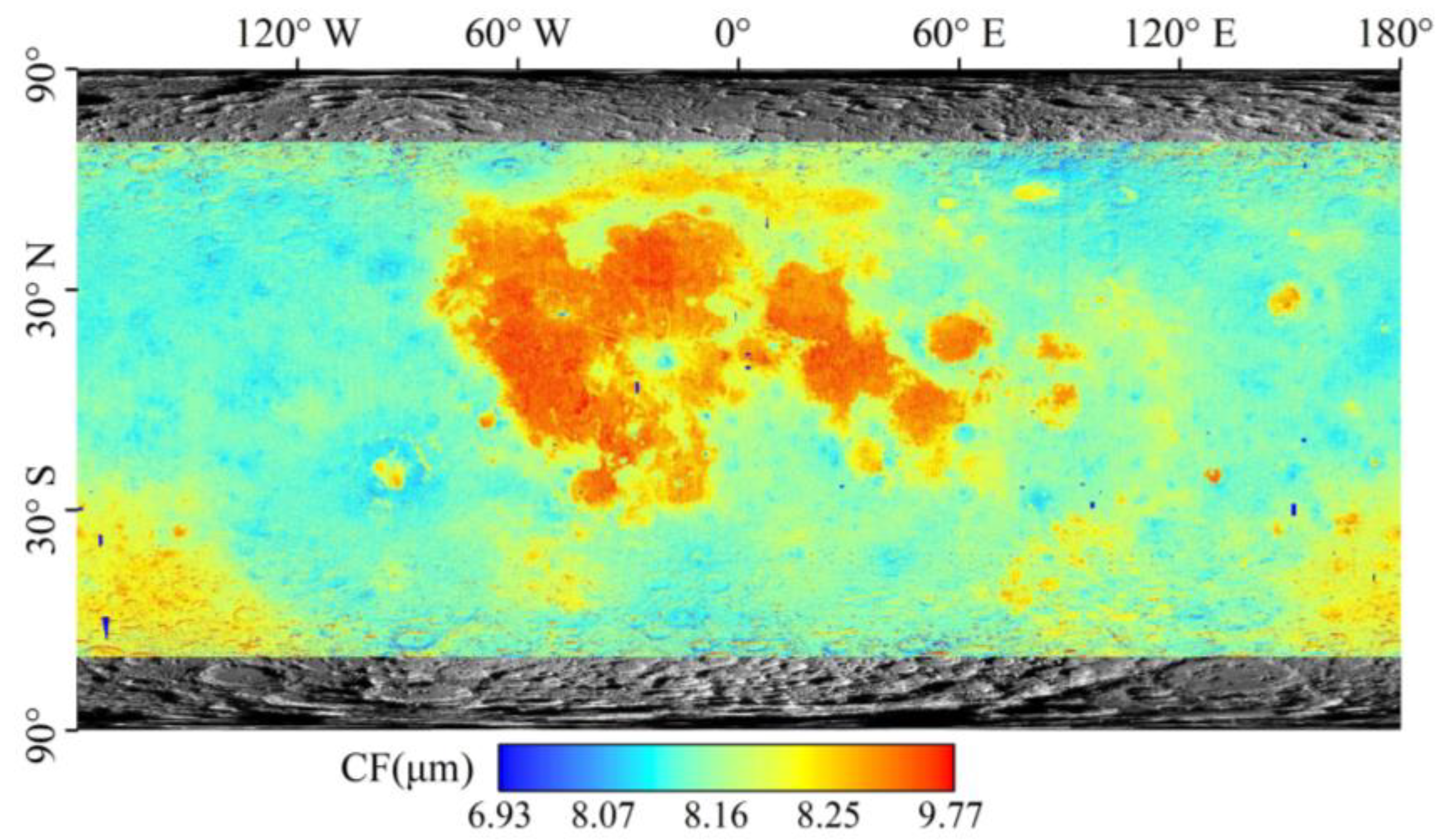
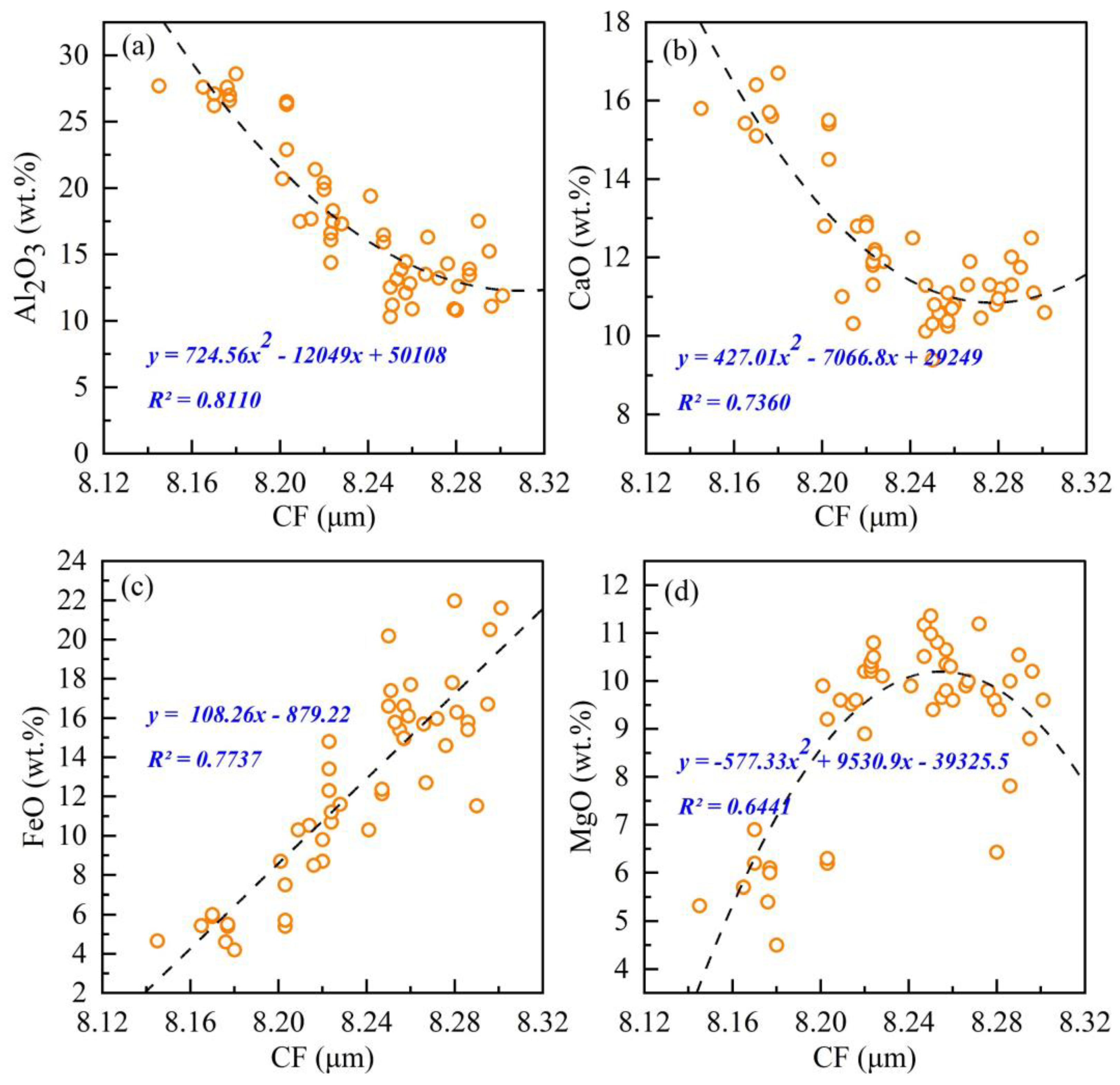
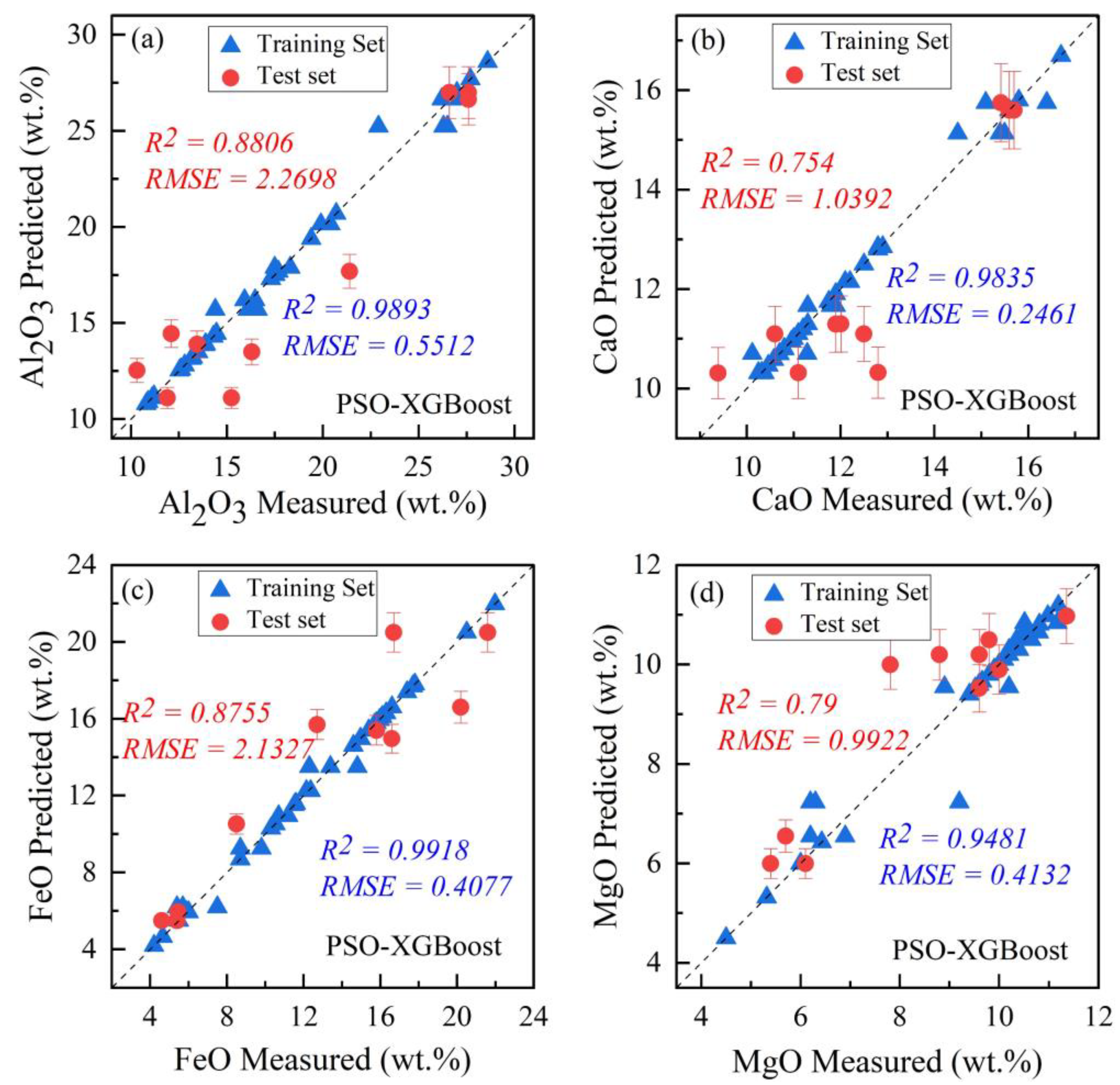
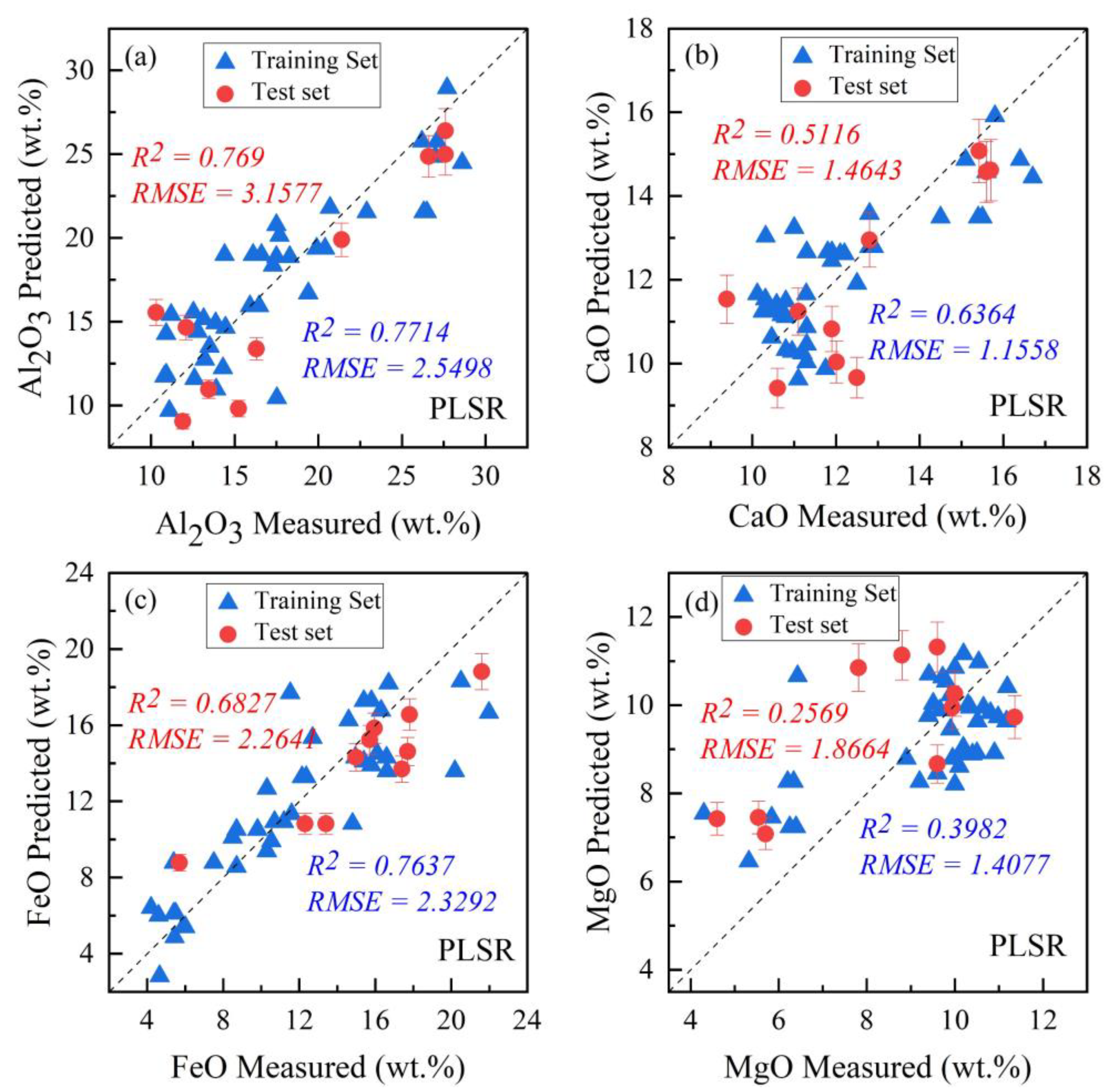
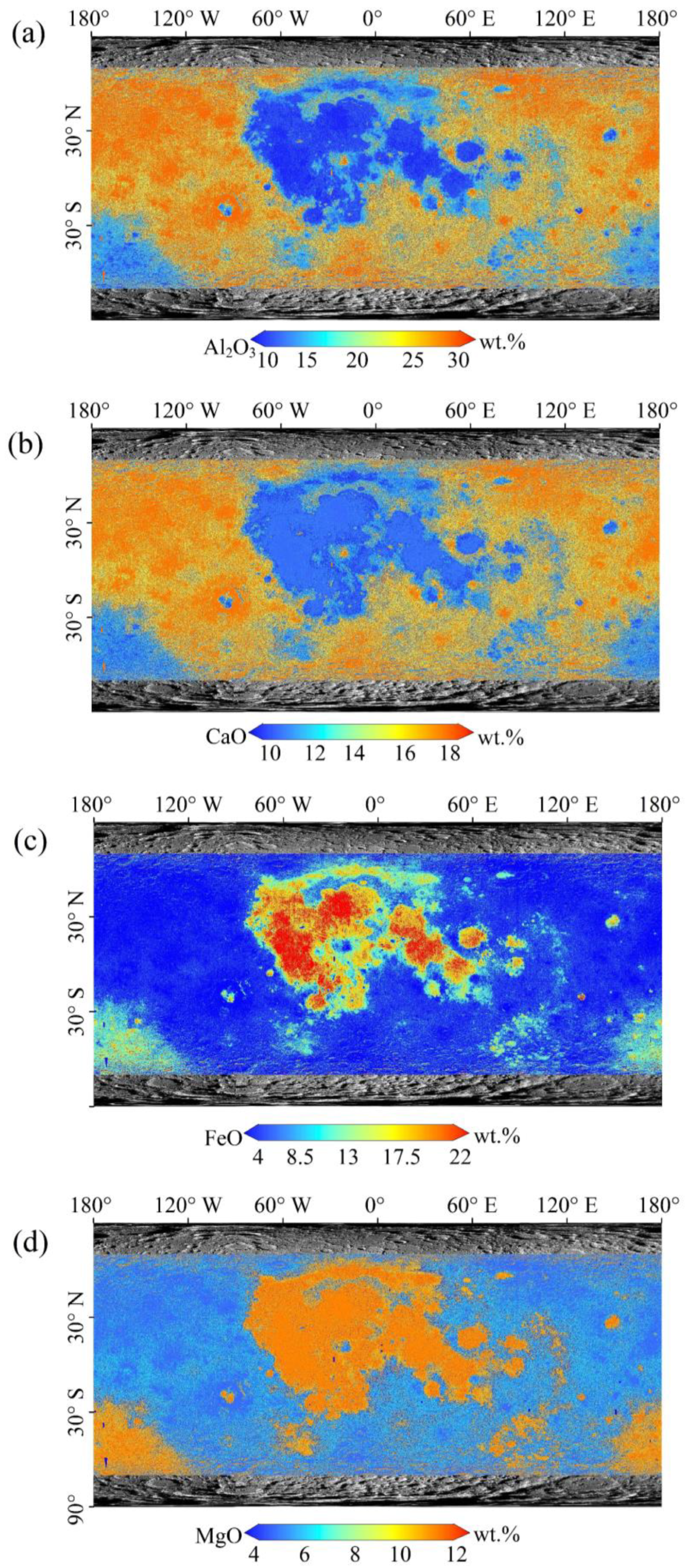
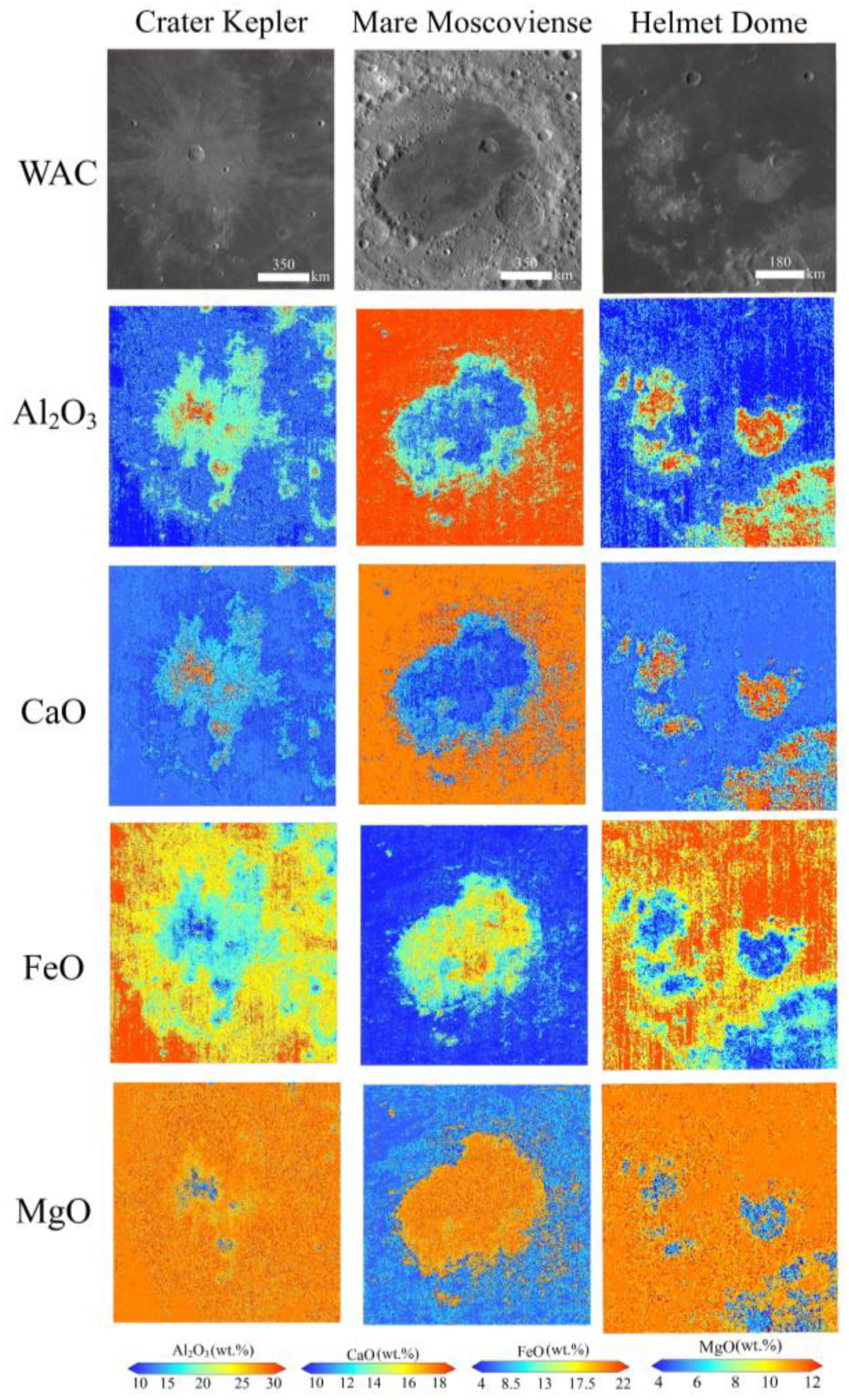
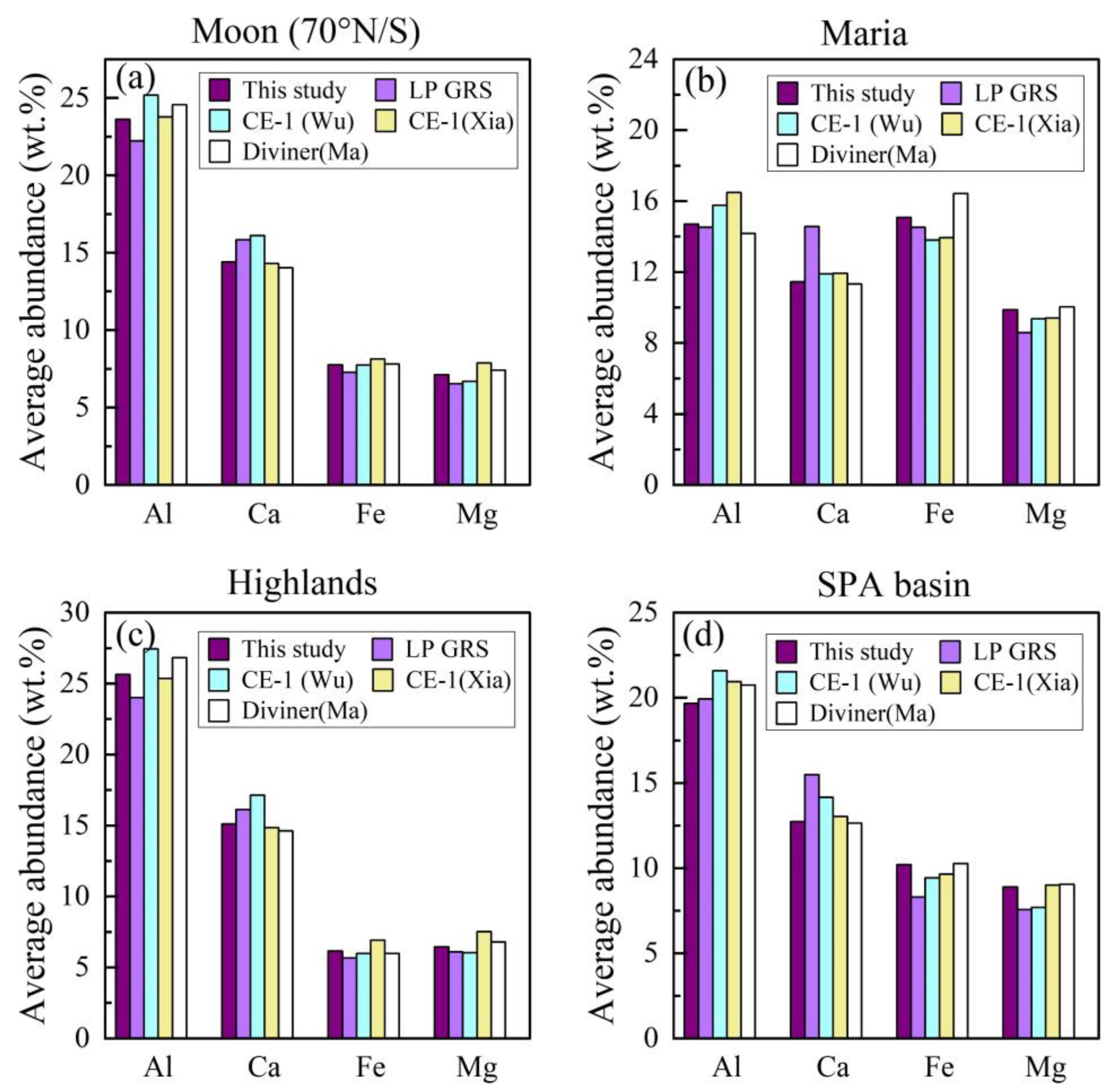

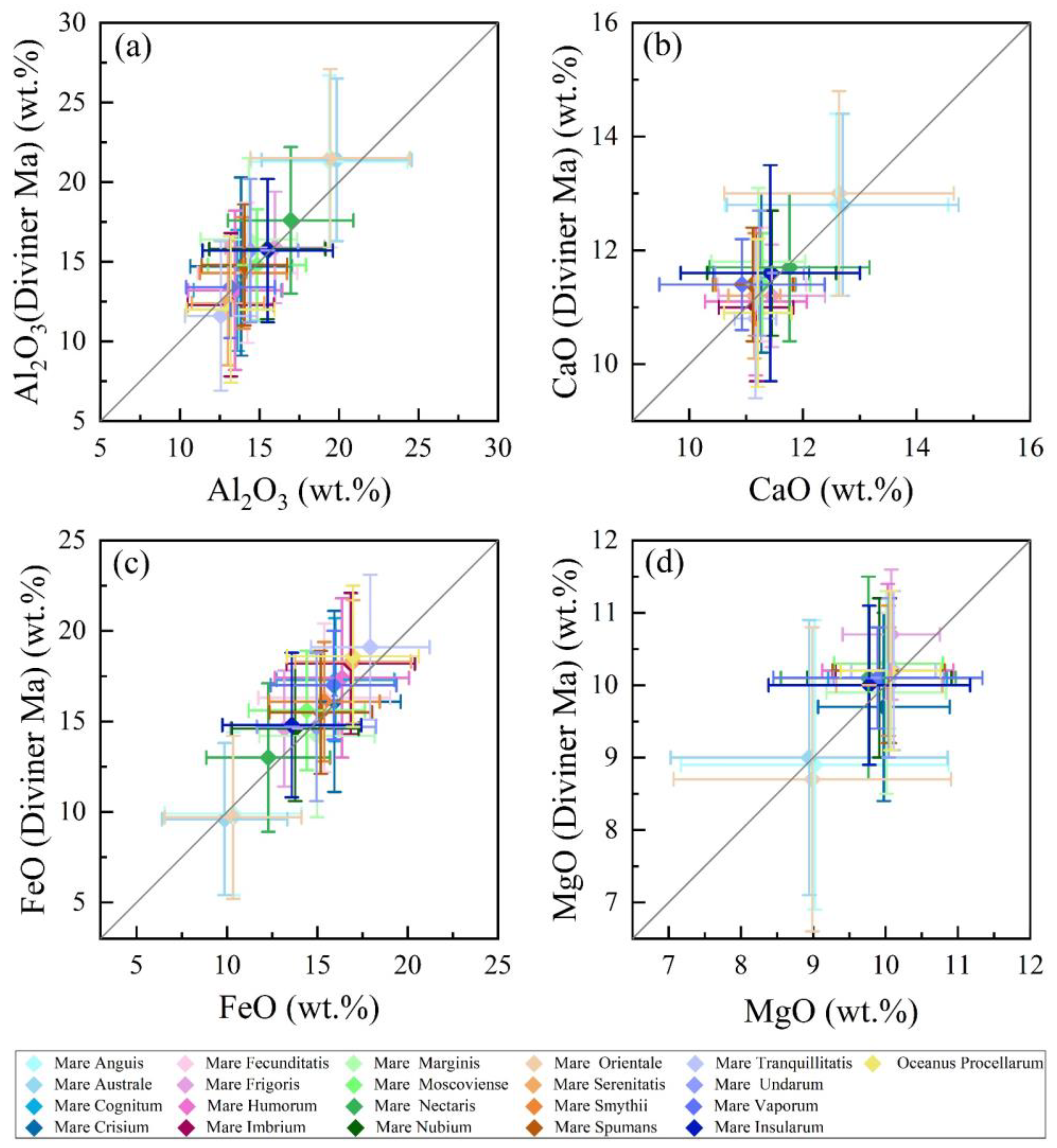

| Site | Al2O3 | CaO | FeO | MgO | CF |
|---|---|---|---|---|---|
| A11 | 13.45 | 12.01 | 15.80 | 7.81 | 8.286 |
| A12 | 13.86 | 10.58 | 15.40 | 9.66 | 8.255 |
| A14-LM | 17.69 | 10.32 | 10.53 | 9.52 | 8.214 |
| A14-Cone | 17.50 | 11.00 | 10.30 | 9.60 | 8.209 |
| A15-LM | 14.45 | 10.25 | 14.95 | 10.65 | 8.257 |
| A15-S1 | 13.15 | 10.58 | 15.79 | 10.81 | 8.253 |
| A15-S2 | 17.52 | 11.75 | 11.52 | 10.54 | 8.290 |
| A15-S4 | 13.22 | 10.46 | 15.96 | 11.19 | 8.272 |
| A15-S6 | 16.47 | 11.29 | 12.14 | 10.51 | 8.247 |
| A15-S7 | 15.92 | 10.12 | 12.37 | 11.17 | 8.247 |
| A15-S8 | 14.46 | 10.38 | 14.98 | 10.35 | 8.257 |
| A15-S9 | 12.54 | 10.31 | 16.61 | 10.98 | 8.250 |
| A15-S9a | 10.31 | 9.39 | 20.19 | 11.36 | 8.250 |
| A16-LM | 27.60 | 15.42 | 5.44 | 5.70 | 8.165 |
| A16-S1 | 26.60 | 15.60 | 5.40 | 6.10 | 8.177 |
| A16-S2 | 27.00 | 15.60 | 5.50 | 6.00 | 8.177 |
| A16-S4 | 27.60 | 15.70 | 4.60 | 5.40 | 8.176 |
| A16-S5 | 26.20 | 15.10 | 5.90 | 6.20 | 8.170 |
| A16-S6 | 27.10 | 16.40 | 6.00 | 6.90 | 8.170 |
| A16-S8 | 26.50 | 15.40 | 5.40 | 6.20 | 8.203 |
| A16-S9 | 26.30 | 15.50 | 5.70 | 6.30 | 8.203 |
| A16-S11 | 28.60 | 16.70 | 4.20 | 4.50 | 8.180 |
| A16-S13 | 27.70 | 15.80 | 4.66 | 5.32 | 8.145 |
| A17-LM | 12.10 | 11.10 | 16.60 | 9.80 | 8.257 |
| A17-S1 | 10.90 | 10.80 | 17.80 | 9.60 | 8.279 |
| A17-S2 | 20.70 | 12.80 | 8.70 | 9.90 | 8.201 |
| A17-S3 | 20.40 | 12.90 | 8.70 | 10.20 | 8.220 |
| A17-S5 | 10.90 | 10.80 | 17.70 | 9.60 | 8.260 |
| A17-S6 | 18.30 | 12.20 | 10.70 | 10.80 | 8.224 |
| A17-S7 | 17.30 | 11.90 | 11.60 | 10.10 | 8.228 |
| A17-S8 | 16.60 | 11.80 | 12.30 | 10.20 | 8.223 |
| A17-S9 | 13.90 | 11.30 | 15.40 | 10.00 | 8.286 |
| A17-LRV1 | 12.60 | 11.20 | 16.30 | 9.40 | 8.281 |
| A17-LRV2 | 16.10 | 11.90 | 13.40 | 10.30 | 8.223 |
| A17-LRV3 | 14.40 | 11.30 | 14.80 | 10.40 | 8.223 |
| A17-LRV4/S2a | 21.40 | 12.80 | 8.50 | 9.60 | 8.216 |
| A17-LRV5 | 19.90 | 12.80 | 9.80 | 8.90 | 8.220 |
| A17-LRV6 | 19.40 | 12.50 | 10.30 | 9.90 | 8.241 |
| A17-LRV7 | 12.80 | 10.70 | 16.10 | 10.30 | 8.259 |
| A17-LRV8 | 13.50 | 11.30 | 15.70 | 9.90 | 8.266 |
| A17-LRV9 | 14.30 | 11.30 | 14.60 | 9.80 | 8.276 |
| A17-LRV10 | 17.50 | 12.10 | 11.20 | 10.50 | 8.224 |
| A17-LRV11 | 16.30 | 11.90 | 12.70 | 10.00 | 8.267 |
| A17-LRV12 | 11.20 | 10.80 | 17.40 | 9.40 | 8.251 |
| Luna16 | 15.24 | 12.50 | 16.70 | 8.80 | 8.295 |
| Luna20 | 22.90 | 14.50 | 7.50 | 9.20 | 8.203 |
| Luna24 | 11.10 | 11.10 | 20.50 | 10.20 | 8.296 |
| CE-3 | 11.90 | 10.60 | 21.60 | 9.60 | 8.301 |
| CE-5 | 10.80 | 10.90 | 22.20 | 6.48 | 8.280 |
| Parameters | Al2O3 | CaO | FeO | MgO |
|---|---|---|---|---|
| n_estimators | 582 | 518 | 530 | 584 |
| learning_rate | 0.1 | 0.1 | 0.1 | 0.1 |
| Parameters | Al2O3 | CaO | FeO | MgO |
|---|---|---|---|---|
| intercept | 1067.8859 | 355.0624 | −831.7237 | −247.5031 |
| coefficient | −127.5548 | −41.6391 | 102.4634 | 31.1801 |
| Global | Maria | Highlands | SPA | |||||
|---|---|---|---|---|---|---|---|---|
| AVG | STD | AVG | STD | AVG | STD | AVG | STD | |
| Al2O3 | 23.63 | 5.64 | 14.71 | 3.98 | 25.66 | 3.86 | 19.80 | 5.18 |
| CaO | 14.42 | 2.10 | 11.45 | 1.18 | 15.12 | 1.66 | 12.74 | 2.20 |
| FeO | 7.78 | 4.47 | 15.09 | 4.31 | 6.16 | 2.64 | 10.01 | 3.98 |
| MgO | 7.14 | 2.15 | 9.88 | 1.10 | 6.46 | 1.80 | 8.81 | 2.04 |
| Mg# | 0.50 | 5.65 | 0.41 | 6.77 | 0.52 | 2.90 | 0.48 | 5.40 |
| Mare | Al2O3 | CaO | FeO | MgO | ||||
|---|---|---|---|---|---|---|---|---|
| AVG | STD | AVG | STD | AVG | STD | AVG | STD | |
| Mare Anguis | 19.39 | 4.91 | 12.59 | 1.97 | 10.34 | 3.77 | 9.02 | 1.85 |
| Mare Australe | 19.85 | 4.72 | 12.70 | 2.04 | 9.87 | 3.47 | 8.94 | 1.91 |
| Mare Cognitum | 13.62 | 2.77 | 11.16 | 0.71 | 16.00 | 3.26 | 10.03 | 0.82 |
| Mare Crisium | 13.84 | 3.19 | 11.27 | 0.84 | 15.94 | 3.67 | 9.98 | 0.91 |
| Mare Fecunditatis | 14.24 | 3.13 | 11.28 | 0.78 | 15.38 | 3.65 | 10.02 | 0.78 |
| Mare Frigoris | 15.97 | 3.12 | 11.45 | 0.94 | 13.18 | 2.99 | 10.08 | 0.67 |
| Mare Humorum | 13.47 | 2.97 | 11.17 | 0.89 | 16.36 | 3.70 | 10.03 | 0.91 |
| Mare Imbrium | 13.19 | 2.71 | 11.18 | 0.66 | 16.85 | 3.55 | 10.06 | 0.75 |
| Mare Marginis | 14.34 | 3.03 | 11.21 | 0.83 | 14.98 | 3.19 | 10.01 | 0.83 |
| Mare Moscoviense | 14.84 | 3.08 | 11.29 | 0.84 | 14.41 | 3.21 | 10.04 | 0.75 |
| Mare Nectaris | 16.96 | 3.95 | 11.76 | 1.41 | 12.28 | 3.42 | 9.76 | 1.21 |
| Mare Nubium | 15.49 | 3.66 | 11.45 | 1.13 | 13.77 | 3.51 | 9.91 | 1.00 |
| Mare Orientale | 19.44 | 5.01 | 12.64 | 2.02 | 10.34 | 3.79 | 8.99 | 1.92 |
| Mare Serenitatis | 13.02 | 2.29 | 11.15 | 0.46 | 16.97 | 3.20 | 10.05 | 0.73 |
| Mare Smythii | 13.99 | 2.73 | 11.16 | 0.69 | 15.39 | 3.06 | 10.04 | 0.78 |
| Mare Spumans | 14.05 | 2.69 | 11.12 | 0.70 | 15.19 | 2.85 | 10.04 | 0.78 |
| Mare Tranquillitatis | 12.57 | 2.26 | 11.16 | 0.37 | 17.93 | 3.28 | 10.11 | 0.58 |
| Mare Undarum | 14.42 | 3.01 | 11.23 | 0.78 | 14.95 | 3.29 | 10.04 | 0.76 |
| Mare Vaporum | 13.18 | 2.79 | 10.93 | 1.46 | 15.90 | 3.48 | 9.89 | 1.45 |
| Mare Insularum | 15.51 | 4.10 | 11.43 | 1.58 | 13.59 | 3.84 | 9.77 | 1.39 |
| Oceanus Procellarum | 13.19 | 2.77 | 11.21 | 0.60 | 16.97 | 3.65 | 10.07 | 0.69 |
Disclaimer/Publisher’s Note: The statements, opinions and data contained in all publications are solely those of the individual author(s) and contributor(s) and not of MDPI and/or the editor(s). MDPI and/or the editor(s) disclaim responsibility for any injury to people or property resulting from any ideas, methods, instructions or products referred to in the content. |
© 2024 by the authors. Licensee MDPI, Basel, Switzerland. This article is an open access article distributed under the terms and conditions of the Creative Commons Attribution (CC BY) license (https://creativecommons.org/licenses/by/4.0/).
Share and Cite
Wu, S.; Chen, J.; Xue, C.; Pan, Y.; Zhang, C. Global Inversion of Lunar Surface Oxides by Adding Chang’e-5 Samples. Remote Sens. 2024, 16, 1812. https://doi.org/10.3390/rs16101812
Wu S, Chen J, Xue C, Pan Y, Zhang C. Global Inversion of Lunar Surface Oxides by Adding Chang’e-5 Samples. Remote Sensing. 2024; 16(10):1812. https://doi.org/10.3390/rs16101812
Chicago/Turabian StyleWu, Shuangshuang, Jianping Chen, Chenli Xue, Yiwen Pan, and Cheng Zhang. 2024. "Global Inversion of Lunar Surface Oxides by Adding Chang’e-5 Samples" Remote Sensing 16, no. 10: 1812. https://doi.org/10.3390/rs16101812
APA StyleWu, S., Chen, J., Xue, C., Pan, Y., & Zhang, C. (2024). Global Inversion of Lunar Surface Oxides by Adding Chang’e-5 Samples. Remote Sensing, 16(10), 1812. https://doi.org/10.3390/rs16101812






